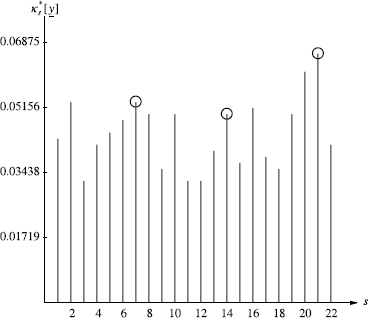4.7 VENONA
During World War II [Wright, 1987; Haynes and Klehr, 1999], the Soviet Union communicated with its legitimate and covert representatives in the United States by
- Diplomatic pouch delivered by a courier,
- Commercial cables, and
- Short-wave radio.

Figure 4.4 Graph of normalized κ-values for cipherEx4.1.
Diplomatic pouches provided security, but communication was slow; it was illegal to encipher messages for transmission by telegraphic cable companies. The Soviet Union was forced to rely on encrypting short-wave radio as a means of secreting their messages.
The Soviet Union operated five communication's channels:
- GRU – Soviet Army General Staff Intelligence Directorate,
- Naval GRU – Soviet Naval Intelligence,
- Diplomatic – Embassy and Consular business,
- Trade traffic – lend lease, The Amtorg Trading Corporation Stands for American Trading Organization (AMTORG), Soviet Government Purchasing Commission, and
- KGB – Soviet espionage; headquarters in Moscow, residencies abroad.
Unlike Japan and Germany, which opted for electromechanical devices, the Soviet Union decided to use the one-time pad, which would provide absolute secrecy if correctly used.
The USSR employed two-part superencipherment (Table 4.9); the first phase used a codebook, a dictionary listing 4-letter groups codes for some set of common (plaintext) phrases. The codebook might have been particular to a specific ...
Get Computer Security and Cryptography now with the O’Reilly learning platform.
O’Reilly members experience books, live events, courses curated by job role, and more from O’Reilly and nearly 200 top publishers.

